Get Crackin’
/11 Comments/in Fruit/by Lee ReichCured!
It’s finally time to get crackin’. Literally. Black walnuts are ready for shelling.
This nutty story goes back to early this past autumn as black walnut trees were shedding their nuts. The nuts fall in their husks, the whole package looking like green tennis balls. Lots of people curse the trees for littering lawns, sidewalks, and driveways. We, on the other hand, praise and collect the nuts.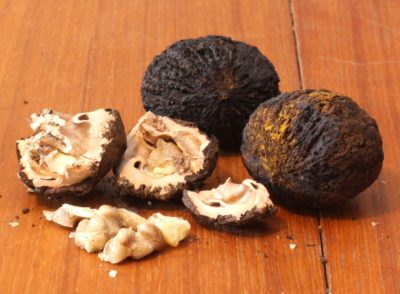
The first step to the present day crackin’ was husking the nuts. The soft, fleshy covering is easy to twist off the enclosed, hard-shelled nut. But we’ve also tried many methods to speed up the process, from spreading the dropped fruit in the driveway and driving over them to pounding them through a 1-1/2” hole in a thick piece of plywood to running them through a suitably modified old-fashioned corn-sheller.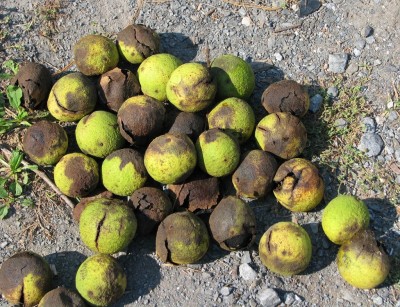
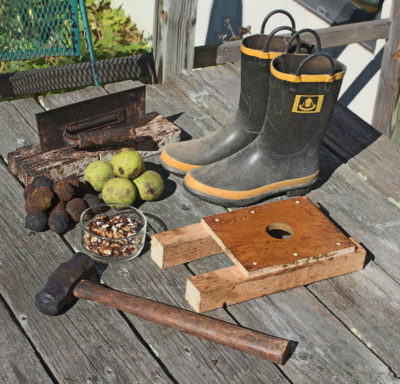
There’s no way around it: Husking black walnuts is a tedious job. And messy, because the soft flesh readily releases a juice which stains everything a deep brown color.
A friend recently told me of some novice black walnut enthusiasts that husked the walnuts bare handed, assuming the stain would wash off when they were finished. Not so. My wife Deb, who husks our black walnuts, chooses to sit herself down on a stool, don rubber gloves, and twist off the hulls, coaxing firm ones off with an initial tap with a light sledge hammer.
(The stain, which is colorfast and resistant to ultraviolet rays, is very easy to extract from the hulls for ink, for dyeing textiles, and staining wood. Just mix the hulls or unhulled nuts with water and boil for awhile or let sit a longer while. Strain and you’re good to go.)
In not too long, we had a number of 5 gallon bucketfuls of hulled nuts — a slimy, ugly mess from bits of hull still attached to the nuts and from the myriad white maggots crawling.
Now it was my turn — to clean up the nuts. I loaded all the nuts into shallow harvest boxes that had plenty of large holes for air or water and drove over to a nearby car wash. After suiting up in an old pair of rain pants, a rain jacket, rubber gloves, and a face shield, and spreading out the boxes on the ground in the car wash, I gave them a thorough, water-only cleaning.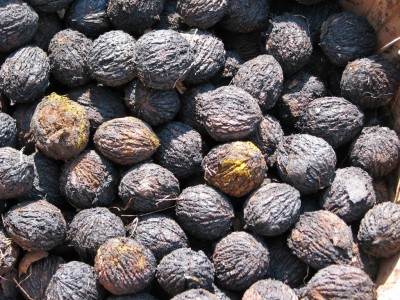
I then spread the boxes out in the sun for a couple of days to dry out the surface of the nuts. Squirrels would be a serious threat but I spread the boxes on our south-facing deck where our two dogs also spend much of the day unknowingly guarding the nuts. Each night, or if any rain was predicted, I stacked and covered the boxes.
After the nuts were sufficiently dry, I stacked the trays in the barn where our cat is the squirrel deterrent.
Then the nuts needed to be cured, which involves nothing more than leaving them alone in a cool, dry, squirrel-fee area. And that brings us up to the present day.
A Tough Nut
Black walnut is a hard nut to crack. No run-of-the-mill nutcracker is up to the job. The usual tool, which is effective, is a hammer against the nut resting on an anvil or concrete. Used with care, a vise might do the job.
Two problems: With the hammer, hitting your finger occasionally as you hold the nut is inevitable. You could, I guess, hold the nut in a pliers. With either method, you have to use just the right amount of force to crack the shell sufficiently in order to extract the nutmeats in reasonable sized pieces without crushing everything too, too small.
The hands-down best job for cracking black walnuts is, in my opinion, the “Master Nut Cracker” (http://www.masternutcracker.com). It’s expensive but well worth the money for the speed with which the nuts can be cracked and the large nutmeats that result from efficient cracking. Besides which, it’s a very well-made tool with a very ingenious design.
Once nuts are cracked, nutmeats still occasionally need further coaxing to free them from the shell. A useful tool that I use that almost everyone has is a type of wire cutter sometimes called a diagonal cutting plier. The right squeeze in the right place, the result of observation and practice, yields large nutmeats that pop right out.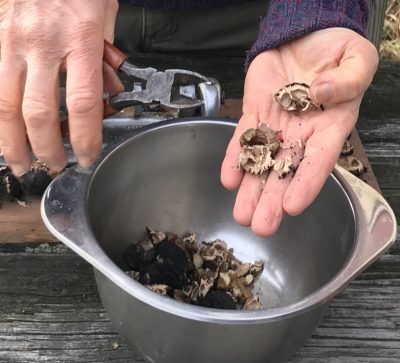
But Is It For You?
Black walnuts have a strong flavor that, like dark beer and okra, is loved by some but not enjoyed by everyone. But there’s no reason why everyone should like everything. Leave that goal to MacDonald’s. As L. H. Bailey, a doyen of horticulture, wrote back in 1922 (about apples), “Why do we need so many kinds of apples? Because there are so many kinds of folks. A person has a right to gratify his legitimate tastes.”
Black walnut is one of my favorite nuts. And, the trees and nuts abound around here, and elsewhere, free for the taking.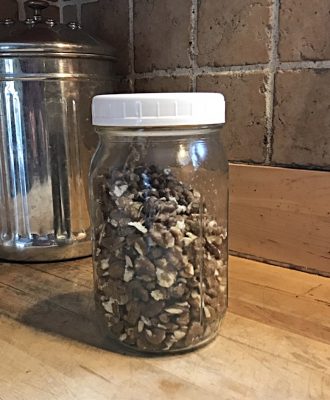
Gardening by the Book
/6 Comments/in Gardening/by Lee ReichAn outdoor temperature of 8.2 degrees Fahrenheit this morning highlighted what a great time winter is for NOT gardening, but for reading about gardening. A lot of gardening books, new and old, end up on my bookshelves, and I’d like to note a few favorites new to my shelves last year.
(Disclaimer: I had a new book published last year, The Ever Curious Gardener — available here. I like the book very much.)
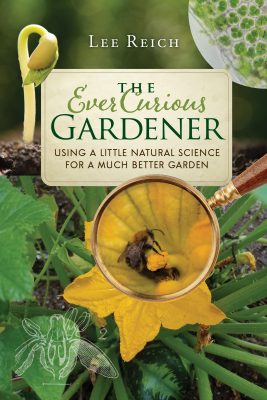
For anyone serious about vegetable growing, Eliot Coleman, gardener extraordinaire, is the author to seek out. The Winter Harvest Handbook builds on his The New Organic Grower (recently re-issued to celebrate its 30th year since publication!) and Four Season Harvest, delving into innovative techniques for growing vegetables more efficiently and year ‘round, with minimum heat inputs even in northern climates.
The “aha” moment for me in reading Eliot’s method’s for year ‘round harvests was that sunlight, even this far north, is not limiting plant growth in winter. New York City and Madrid are at the same latitude! Mediterranean gardeners don’t abandon their vegetable gardens in winter; they just change plants, growing vegetables, such as spinach, lettuce, cabbage, and radish, that tolerate and enjoy cold weather. What we need on this – the cold side – of the big pond are ways to contain the earth’s heat and/or to provide heat efficiently to keep plants alive and growing. Read the book.
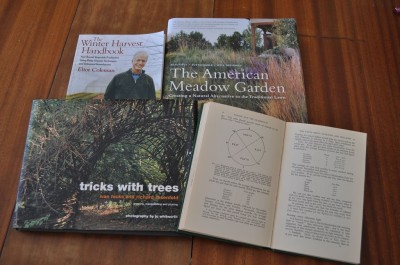
The title of the book Tricks with Trees, by Ivan Hicks and Richard Rosenfeld, doesn’t do justice to the neat things shown that people have done, and you could do, with trees. How about a tree trained as a chair, a living chair? Don’t expect to move such a chair anywhere because it’s rooted in the ground. One of my other favorites in the book is the “cloud seat.” (Use your imagination and you might guess what this is.)
People love the idea of meadows, perhaps because meadows seem low maintenance, perhaps because humans originated in the savannahs of Africa. Meadows have become very popular over the last few decades, and lots has been written about them. (I even have a meadow section in my book Weedless Gardening.) The American Meadow Garden, by John Greenlee, offers all you need to know and to grow a meadow. Saxon Holt’s photographs were so inspiring I contemplated turning my one-acre meadow into, well, more of a meadow. After seeing the photograph on page 41, I want shooting stars, a milkweed relative, in my meadow, which gets nothing much more than a yearly mowing.
Greenlee’s book does keep you grounded with plenty of information about the plants, about preparing the ground, and about maintenance, especially weed control. Maintenance? Weed control? Yes, a meadow, depending on your aspirations, may need both. My only beef with this book is that Greenlee makes no mention of mowing with a scythe, a most pleasant and very efficient tool for meadow maintenance.
Last, but certainly not least, is Science and the Glasshouse by William Lawrence. If the title sounds a bit old-fashioned, it’s because the book is old-fashioned; it was written in 1950. I visited Eliot Coleman this past summer and sometime during the visit we were lobbing titles of our favorite books back and forth. He threw me this one after I had lobbed to him Intensive Gardening, by Rosa O’Brien, also 1950 vintage and one of my favorite gardening books of all time (and one he had suggested to me back in 1973).
Back to Science and the Glasshouse, which I ordered asap, actually asaicgo (as soon as I could get online). My favorite thing about this book is that it challenges many commonly held notions by testing them scientifically. Mr. Lawrence, then head of the Garden Department of the acclaimed John Innes Horticultural Institute in Britain, subjected to scientific inquiry such beliefs as: cold soil is harmful to potted seedlings (it is not); crowding potted plants decreases growth of individual plants (sometimes); size matters, in pots for transplants (yes), and so on.
The second half of the book is devoted to the “glasshouse,” which greenhouses literally were back then. Mostly, his testing showed that plants in greenhouses did not always get all the light they should, not because of a lackadaisical old sol but because of dirty glass, poor orientation, and other things we can control. Which brings us around full circle back to Eliot Coleman’s capitalizing on winter sunlight.
Some Dirt Under the Fingernails
Okay, I am, in fact, doing a little gardening. I went down to the basement and brought 2 amaryllis plants upstairs to get them started growing for blossoms in February(?).
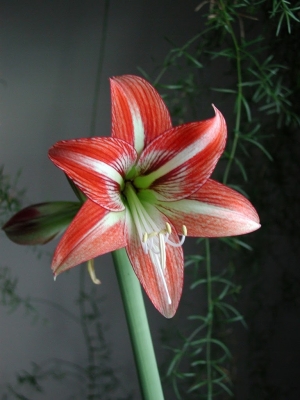
A Wizening Little Tree
/4 Comments/in Gardening/by Lee ReichNow, in its tenth year, my weeping fig is just waking up. (This plant is not one of my edible figs weeping from sadness, but a species of fig — Ficus benjamina — with naturally drooping branches.) As a tropical tree, its sleep was not natural, but induced, by me.
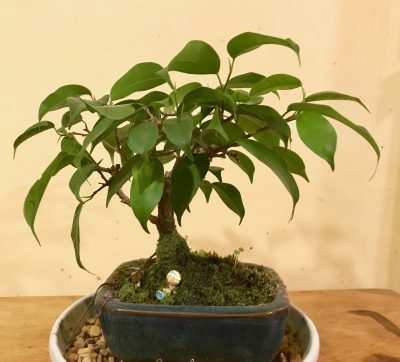
In its native habitat in the tropics, weeping fig grows to become a very large tree that rivals, in size, our maples. The effect is all the more dramatic due to thin aerial roots that drip from the branches, eventually fusing to create a massive, striated trunk. Because the tree tolerates low humidity, it’s often grown as a houseplant. Growth is rapid but with regular pruning the plant can be restrained below ceiling height.
At ten years old, my weeping fig is about four inches tall with a trunk about 5/8 inch in diameter and no aerial roots. Four inches was about the height of the plant when I purchased it in the houseplant section of a local lumberyard. Actually, four of these plants were growing in a 4 inch square pot. I separated them and potted one up with the idea of creating a bonsai.
The bonsai has been a success. Each year the trunk and stems have thickened to create the wizened appearance of a venerable old tree, in miniature. The soil beneath the spreading (if only 3 inch) limbs is soft with moss which has crept slowly up the lower portion of the trunk.
To Sleep, My Little Tree
Even after ten years the plant is in the same pot in which I originally planted it, a 4 by 6 inch bonsai tray only about an inch deep. Biannual repotting and pruning has been necessary to keep the stems and roots to size, and to refresh the potting soil to provide nutrients and room for roots to run (albeit very little room for a tree with such size potential).
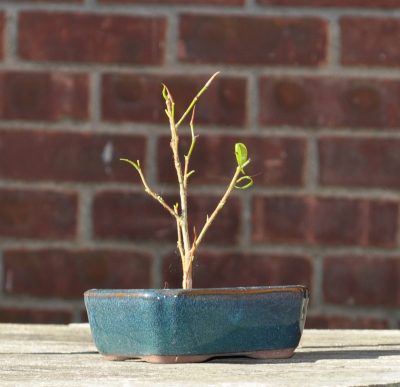
Back to my tree’s sleep: A few weeks ago, the sun dipping lower in the sky for a shorter time each day seemed to me like a good time to give the plant a rest, which it surely would be taking following my operation.
I began with the roots. After tipping the plant out of its pot, I used a fork to tease soil away from the bottom of the root ball. Roots left dangling down in mid air as I held the plant aloft were easy to trim back. I was careful to leave the top portion of the roots and soil undisturbed in order to keep the mossy blanket intact.

With enough fresh potting soil added to the pot so the tree (despite its size, I think I can call it a “tree”) would sit at the same height in the pot as previous to pruning, the tree was ready to return to its home. I firmed it in place.
Next, I turned to the above ground portions of the plant, beginning by pruning stems so the tree would look in proportion to the size of its container and to maintain the increasingly rugged look of a tree, in miniature, beyond its actual years.
Finally, I clipped each and every leaf from the plant. This shocks the plant to sleep and reduces water loss, important for a plant from which a fair share of its roots have been sheared off. Clipping off leaves also induces more diminutive growth in the next flush of leaves, so they are more in proportion to the size of the whole plant.
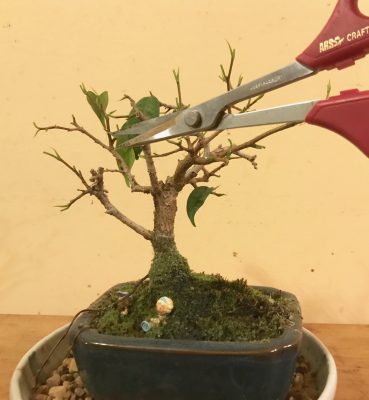
After a thorough watering, the tree was back in its sunny window. And there it sat, leafless, until a few days ago, when small, new leaves emerged.
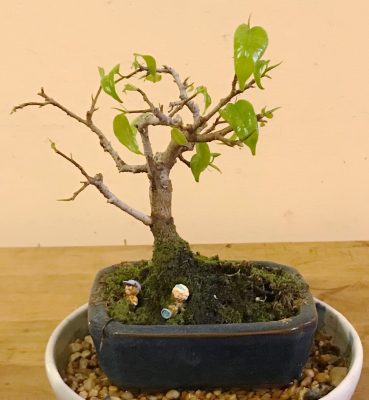
Pruning Moves Outdoors, Prematurely Perhaps
Pruning and repotting the bonsai wasn’t enough gardening for me. A couple of sunny days couldn’t help but drive me outdoors. A pile of wood chip mulch delivered a few months ago beckoned me; I spread it in the paths between my vegetable beds, a pre-emptive move to smother next season’s weeds.
I don’t usually prune this time of year (The Pruning Book, by me, recommends against it!), but couldn’t restrain myself. I started with the gooseberries and currants, both of which are super cold hardy plants so are unlikely to suffer any damage from pruning now. Plus, they start growth very early in spring.
Any of this gardening could be postponed until late winter or early spring. But why wait?

